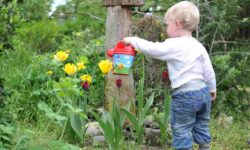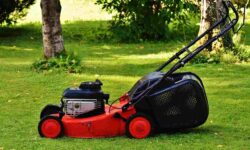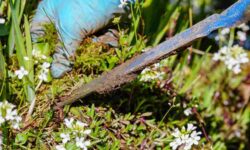Last updated on March 22nd, 2024 at 01:16 am
Gardening is a joyful and therapeutic activity, but for those living with arthritis, it can pose challenges. Thankfully, a range of specially designed gardening tools for people with arthritis exists to make this hobby more accessible and enjoyable. These ergonomic tools are crafted to reduce strain, pain, and fatigue, enabling gardeners with arthritis to continue nurturing their green spaces with ease and comfort.
What Challenges Does Gardening Pose to People With Arthritis?
Gardening poses several challenges for people with arthritis due to the physical demands of the activity. Arthritis can lead to pain, stiffness, and reduced mobility in joints, making tasks like digging, weeding, and pruning difficult.
Bending, kneeling, or gripping tools tightly can exacerbate pain and inflammation in affected joints. Additionally, the repetitive nature of gardening tasks can increase strain on already sensitive areas.
The effort required to carry heavy loads, such as soil or water, can also be problematic, limiting the ability to engage in gardening comfortably and enjoyably.
Also Check: Gardening Tools for People With Bad Backs
What Precautions Should People With Arthritis Take While Gardening?
People with arthritis should take several gardening precautions to avoid strain and flare-ups. First, warm up with gentle stretches to prepare joints and muscles.
Use ergonomic tools with easy-to-grip handles and lightweight designs to reduce joint stress. Opt for raised beds and container gardening to minimize bending and kneeling.
Take frequent breaks to prevent overexertion, and stay hydrated. Consider wearing supportive gloves to protect your joints and enhance grip. Listen to your body’s signals and adjust activities accordingly to prevent discomfort.
Here are the top ten gardening tools for people with arthritis.
Affiliate Disclosure: Please note that some of the links in this post are affiliate links, and at no additional cost to you, we earn a commission if you make a purchase by clicking those links.
1. Ergonomic Hand Tools
Long-handled tools are a boon for gardeners with arthritis, significantly reducing the need to bend, stoop, or kneel while tending to their plants. These tools, including rakes, hoes, and cultivators, feature extended handles, allowing individuals to reach the ground or deep into flower beds. This design minimizes stress on the back, knees, and hips, often affected by arthritis.
Long-handled tools help prevent pain and fatigue by limiting these movements, making gardening more manageable and enjoyable. They enable gardeners with arthritis to maintain their hobby with less discomfort, fostering independence and enhancing quality of life through outdoor activity.
2. Lightweight Garden Hose
A lightweight garden hose supports people with arthritis by reducing the physical effort needed to water plants.
Traditional hoses can be heavy, requiring significant strength and skill to maneuver, which can strain joints and exacerbate arthritis symptoms.
In contrast, a lightweight hose is more accessible to carry, pull, and coil, minimizing the stress on hands, wrists, and shoulders.
This ease of use allows individuals with arthritis to maintain their gardens without facing the added pain or discomfort associated with handling heavier equipment, making gardening a more accessible and enjoyable activity.
3. Kneeler Seats
Kneeler seats are a dual-purpose tool designed to help people with arthritis during gardening. They offer a comfortable, padded seat for sitting while working on raised beds or pots, reducing the need to bend or stoop. This helps in minimizing strain on the back, hips, and knees.
When flipped over, these seats serve as a cushioned support for kneeling, protecting the knees from hard ground and making it easier to rise after working close to the soil.
This versatility makes kneeler seats invaluable for maintaining gardening activities without exacerbating arthritis symptoms, allowing for more extended periods of comfortable gardening.
4. Long-handled Tools
Long-handled tools are a boon for gardeners with arthritis, significantly reducing the need to bend, stoop, or kneel while tending to their plants. These tools, including rakes, hoes, and cultivators, feature extended handles, allowing individuals to reach the ground or deep into flower beds.
This design minimizes stress on the back, knees, and hips, often affected by arthritis. Long-handled tools help prevent pain and fatigue by limiting these movements, making gardening more manageable and enjoyable.
They enable gardeners with arthritis to maintain their hobby with less discomfort, fostering independence and enhancing quality of life through outdoor activity.
5. Electric Weeders
Electric weeders offer a highly effective solution for gardeners with arthritis by eliminating the need for manual weeding, which can be a strenuous and painful task.
These devices use electricity to target and remove weeds without requiring the gardener to bend down or use force with their hands. This reduces the strain on the back, knees, and especially the hands and wrists, areas often affected by arthritis.
The ease of use and efficiency of electric weeders mean that maintaining a weed-free garden becomes less of a physical challenge, allowing individuals with arthritis to enjoy gardening without exacerbating their condition.
6. Ratchet Pruners
Ratchet pruners are designed to make cutting through branches and stems less physically demanding, a common challenge for those with arthritis. These pruners have a mechanism that multiplies the force the user applies, allowing for easier cutting with minimal effort.
This feature is particularly beneficial for gardeners with reduced hand strength or grip issues, as it significantly reduces the strain and pressure needed to prune.
Ratchet pruners enable individuals with arthritis to engage in pruning activities without the pain or fatigue that might come from using standard pruning tools, thus making gardening more accessible and enjoyable.
7. Garden Stool on Wheels
A garden stool on wheels is an invaluable tool for gardeners with arthritis, enhancing mobility and comfort. This movable stool allows individuals to sit while working, reducing strain on the back, knees, and hips by avoiding prolonged periods of standing or bending.
The wheels provide the added benefit of easy movement around the garden, eliminating the need to stand up and down frequently, which can be challenging for those with arthritis.
This tool supports a more comfortable gardening experience and promotes longer gardening sessions by minimizing pain and fatigue associated with arthritis.
8. Swivel Grass Shears
Swivel grass shears are designed to make trimming grass and edges easier for people with arthritis. The swivel feature allows the blades to rotate, enabling the user to cut at different angles without twisting their wrist or adopting uncomfortable positions.
This reduces strain on the wrists and hands, areas often affected by arthritis, making it easier to maintain neat lawn edges and prune plants without exacerbating pain.
These shears provide a practical solution for detailed gardening work, allowing individuals with arthritis to engage in maintenance tasks with greater ease and comfort.
9. Foam Grips
Foam grips can be added to existing gardening tools to make them more comfortable for individuals with arthritis. These grips provide a thicker, softer handle, which reduces the grip strength needed and minimizes pressure on the joints in the hands and fingers.
The cushioning effect of foam grips helps prevent fatigue and pain, making tools more accessible and more comfortable for extended periods.
By modifying tools with foam grips, gardeners with arthritis can improve their grip strength and control, making gardening tasks less daunting and more enjoyable.
10. Drip Irrigation Systems
Drip irrigation systems provide a convenient and efficient watering solution for gardeners with arthritis. By delivering water directly to the base of plants, these systems reduce the need for manual watering with heavy watering cans or hoses, tasks that can be challenging and painful for individuals with arthritis.
Installing a drip irrigation system can be a one-time effort that pays off in the long term, minimizing the physical labor associated with gardening and allowing for better water management.
This automated watering method makes it easier for people with arthritis to maintain their gardens without the strain and fatigue associated with traditional watering methods.
Read More: Power Gardening Tools You Must Have
How These Gardening Tools Help People With Arthritis
Here are how these gardening tools help people with arthritis.
| Tool | How It Helps People with Arthritis |
|---|---|
| Ergonomic hand tools | Designed with soft, non-slip grips to minimize hand pain and fatigue, making them easier to hold and use. |
| Lightweight garden hose | Made from lighter materials, these hoses are easier to carry and pull around the garden, reducing the physical effort required. |
| Kneeler seats | Provide a comfortable seat or kneeling pad, helping to avoid the strain of bending down, which can be particularly beneficial for gardening at ground level. |
| Long-handled tools | Extend reach to the ground or deep into beds without the need to bend over or stretch, reducing back and knee stress. |
| Electric weeders | Remove weeds without the need for manual pulling, which can be difficult and painful for those with hand and wrist arthritis. |
| Ratchet pruners | Equipped with a mechanism that multiplies the force applied, allowing for easier cutting with less effort from the user. |
| Garden stool on wheels | Offers a mobile seating option to move easily around the garden without standing up, reducing knee and back strain. |
| Swivel grass shears | Feature blades that rotate to allow cutting at different angles without requiring the wrist to twist, thereby reducing wrist strain. |
| Foam grips | Can be added to existing garden tools to provide a thicker, softer handle, which is easier to grip and reduces hand fatigue. |
| Drip irrigation systems | Automate the watering process, eliminating the need for frequent manual watering and hauling water, which can be labor-intensive. |
How Do You Garden With Bad Knees?
Gardening with bad knees requires minimizing strain using tools that enhance comfort and accessibility. Opt for long-handled tools to avoid bending and kneeler seats or a garden stool on wheels for low-to-the-ground tasks. Consider raised beds or container gardening to bring plants to a more accessible height.
A drip irrigation system can also reduce the need to carry heavy watering cans, making gardening more knee-friendly.
Read More: Ten Useful Gardening Tools for Disabled Persons
How Can I Garden Without Hurting My Knees?
To garden without hurting your knees:
- Use raised beds or containers to elevate plants to waist level, reducing the need to bend.
- Invest in a good kneeler seat or pad for cushioning when lower tasks are unavoidable.
- Choose long-handled tools to extend your reach and minimize bending.
- Consider a garden stool on wheels for easy mobility around the garden.
These strategies can help protect your knees from strain and injury.
Enjoy Gardening With Gardening Tools for People For Arthritis
While arthritis can present significant challenges to gardening, innovative tools and strategies offer practical solutions. Ergonomic tools, designed with the needs of individuals with arthritis in mind, can significantly reduce pain, strain, and fatigue, making gardening a more accessible and enjoyable activity.
By selecting the correct aids, such as lightweight hoses, kneeler seats, and drip irrigation systems, gardeners with arthritis can continue cultivating their passion for gardening without compromising their comfort or health.
Embracing these gardening tools for people with arthritis helps maintain a beloved hobby and enhance the quality of life through the therapeutic benefits of gardening.
Disclaimer: These tools are listed for information purposes only. Consult your medical professional before using these tools if you are advised not to do gardening due to arthritis.
Additional Resources:
- Best Gardening Tools for Seniors
- Ten Useful Gardening Tools To Remove Weeds
- Gardening Tools for Kids



